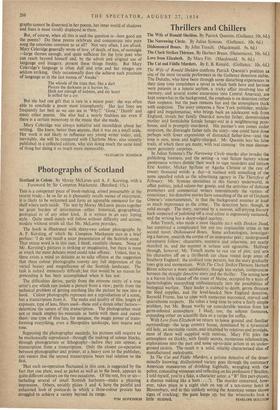Thrillers and Chillers
The Wife of Ronald Sheldon. By Patrick Quentin. (Gollancz. 10s. 6d.) The Cat and Fiddle Murders. By E. B. Ronald. (Gollancz. 10s. 6d.)
The Wife 'of Ronald Sheldon confirms Patrick Quentin's position as One of the most versatile performers in the Gollancz detection stable. The Duluths, who have been through some disturbing experiences in their time (one remembers a novel in which both hero and heroine were patients in a lunatic asylum, a tricky affair involving loss of memory, and several exotic excursions into Central America), are kept somewhat in the background, the emphasis is on detection rather than suspense, but the pace remains fast and the atmosphere thick with suspicion. The story concerns a New York publisher, middle- aged and megalomaniac, who brings back an adolescent wife from England, instals her family (bearded novelist father, downtrodden mother and formidable female hanger-on) in a neighbouring pent- house, and is promptly murdered. His partner's son comes under suspicion, the distraught father tells the story—one could have done perhaps with fewer expressions of distracted father-love=and the tone is sure, tense and highly-charged. Mr. Quentin lays his false trails, of which there are many, with real cunning: the neat denoue- ment genuinely surprises.
In Julian Symons's The Narrowing Circle murder also invades the publishing business, and the setting—a vast fiction factory whose anonymous writers dictate their work to tape recorders and imitate Eric Ambler, Mickey Spillane or Agatha Christie at the rate of twenty thousand words a day—is realised with something of the same appalled relish as the advertising agency in The Thirtyfirst of February. Mr. Symons specialises in this literary underworld, in office politics, jaded saloon-bar gossip, and the activities of dubious promoters and commercial writers intermittently the victims of conscience; his detective stories have something of the air of Graham Greene's `entertainments,' in that the background assumes at least as much importance as the crime. The detection here, though, is solid enough. The story, narrated by a morose, self-pitying literary hack suspected of polishing off a rival editor is ingeniously sustained, and the writing has a sharp-edged acerbity.
John Trench, who made a most likeable stall with Docken Dead, has contrived a complicated but not too implausible crime in his second novel, •Dishonoured Bones. Some archeologists, investigat- ing a barrow, unearth the corpse of an unpopular peer; underground adventures follow; characters, eccentric and otherwise, are neatly sketched in, and the manner is urbane and agreeable. Halfway through, however, Mr. Trench seems to run out of plot, and sets his characters off on a thrillerish car chase round large areas of Southern England: the civilised tone persists, but the story gradually loses grip and momentum. With The Clock Strikes Thirteen, Herbert Brean achieves a more satisfactory, though less stylish, compromise between the straight detective story and the thriller. The setting here is a barren little island off the coast of Maine, occupied by a team of bacteriologists researching enthusiastically into the possibilities of biological warfare. Their leader is stabbed to death, germs threaten the food supplies, and the level-headcd New England detective, Reynold Frame, has to cope with numerous marooned, starved and quarrelsome suspects. He takes a long time to solve a fairly simple problem, but Mr. Brean works up considerable tension from his germ-infested atmosphere. I liked, too, the solemn footnotes, expanding either on scientific data or a recipe for coffee.
With Love from Elizabeth we return to home ground and familiar surroundings—the large country house, dominated by a tyrannical old lady, an inevitable victim, and inhabited by relatives and proteges. most of them well supplied with motives. Mary Fitt piles the atmosphere on thickly, with family secrets, mysterious relationships, explorations into the past and some up-to-date action in an under- ground cavern. The result is a solid, reliably characterised slice of manufactured melodrama.
In The Cat and Fiddle Murders, a private detective of the deter- minedly knowing, disillusioned variety goes through the customary American manoeuvres of drinking highballs, wrangling with the police, concealing witnesses and reflecting on his profession (' Bradley, I told myself, you're a fake, a character actor, a "B" film part-player, a shamus making like a ham ....'). The murder concerned, how- ever, takes place in a night club on top of a ten-storey hotel in
Bloomsbury, and in this unlikely setting the American veneer shows signs of cracking; the pace keeps up, but the wisecracks look a


































 Previous page
Previous page